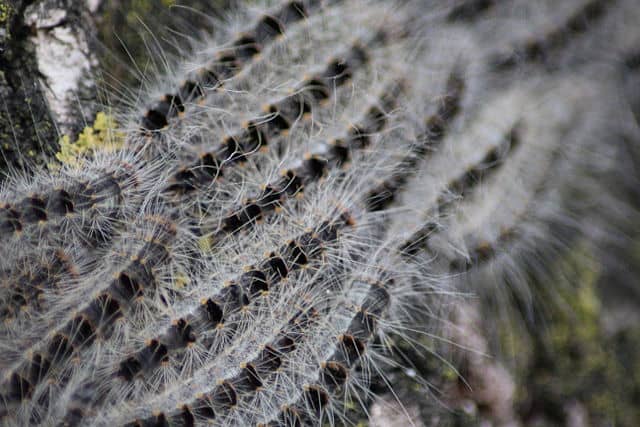
A plague of toxic caterpillars which cause painful rashes and can threaten the lives of asthma sufferers has struck – Milton Keynes.
Thousands of Oak Processionary caterpillars have appeared in gardens and parks across the Buckinghamshire new town in the last few days.
And residents have complained about suffering reactions after touching the caterpillars which are dark in colour and around 25mm in length.
The caterpillars, which later turns into a moth, are covered in long white hairs.
The barbed hairs have a protein in them which causes irritation, they can often get caught in breezes and land on people’s skin.
Experts warn that if they get in contact with human skin they cause cause itchy rashes, eye problems and sore throats.
In extreme cases, especially for those with asthma, it can cause breathing difficulties, they have warned.
The caterpillars can defoliate oak trees however it is the irritant (urticating) hairs that have the potential to cause health problems to humans and animals. For medical advice see NHS choices.
The moth is native to southern Europe but has recently become more widespread in northern Europe. It appeared in South West London in 2005 and has since become widespread in West and South West London. There have also been outbreaks in East London, Hertfordshire, Berkshire and parts of Surrey.
It is the subject of a control and containment programme co-ordinated by the Forestry Commission.
The Forestry Commission have asked the public to report any sightings of the caterpillar, or their white web looking nest, online.
Young mum Britney Comayas, 22, told how she suffered from a severe rash shortly after she visited the town.
She said she was visiting her parents last Thursdsay with her two year old son Shane when she thinks she brushed past the caterpillar.
She said: “I reckon my rashes are from that [the caterpillar] because as soon as I arrived in Milton Keynes last week I started getting a rash and it spread everywhere.
“It started with two red spots on my arm but by the next morning my spots were spreading and it looked like chicken pox.”
But when Britney spoke to doctors and A&E staff she was left without any answers.
She said: “No doctors know what it is, I’ve taken fexofenadine and acicclovir (both antihistamines) and put calamine lotion but I still have the rash, and it’s very itchy.”
Other Milton Keynes victims of the caterpillars, which are not native to the UK but started appearing in London in summer 2015, have shared their pain on Facebook.
Jyll Beckford said: “I suffered an itchy sore rash after some gardening last weekend it’s healing now. I thought it might be some sap from plants now maybe this is the cause”
Another woman also commented: “My husband has it down his face & arms really baldly. Had the same last year but wasn’t sure what had caused it.”
A Forestry Commission spokesperson said: “We are working with Local Authorities and land managers to share best practice and to deliver a control programme of surveillance and treatment to tackle Oak Processionary Moth (OPM).
“The majority of the UK is a designated Protected Zone for this pest and we have recently strengthened import controls on oak trees to mitigate against further risks.
“The pest is a native of southern Europe and first discovered in the UK in 2005.
“The OPM caterpillars, or larvae, emerge in spring and feed on oak leaves leaving the trees vulnerable to other pests and diseases.”
By Ben Gelblum and Amelia Wynne
Main photo of moths (c) Kleuske CC